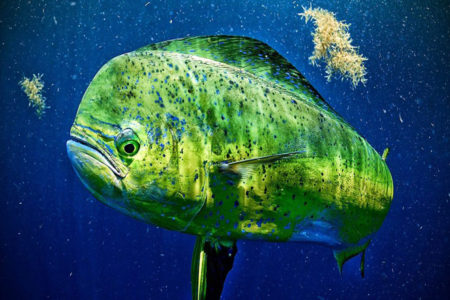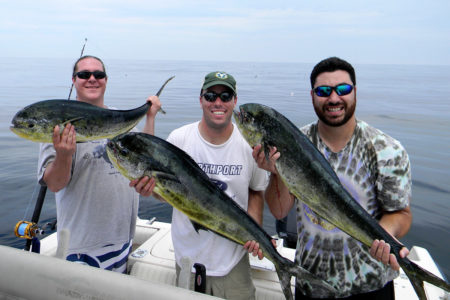If the last two summers show a pattern, this month should be a good one.
July 25, 2019 – My journal entry from that day – “Tuna fishing was a bit slow so Driscoll and I stopped at the Glory Hole on the way home to see if any life was hanging around the minefield of pot buoys. As we slid up onto the first pot ball we both buckled our knees with the size of the shadow under the ball. I tossed out a half-ounce home-tied white bucktail tipped with a Berkley Gulp 4-inch swimming minnow and pulled that shadow off the pot. It took three swings at the lure before it finally decided it was convincing enough to swallow – a 28-pound dolphin! After high fives and photos, we cleaned up on 2- to 6-pound mahi for the rest of the afternoon working the pots with bucktails.”
Want in on the dolphin action? Now’s the time. Late summer opportunity to target dolphin around pot buoys has exploded along the coast from New England down to the Jersey Shore in recent years. Here’s a few pro tactics to try out.
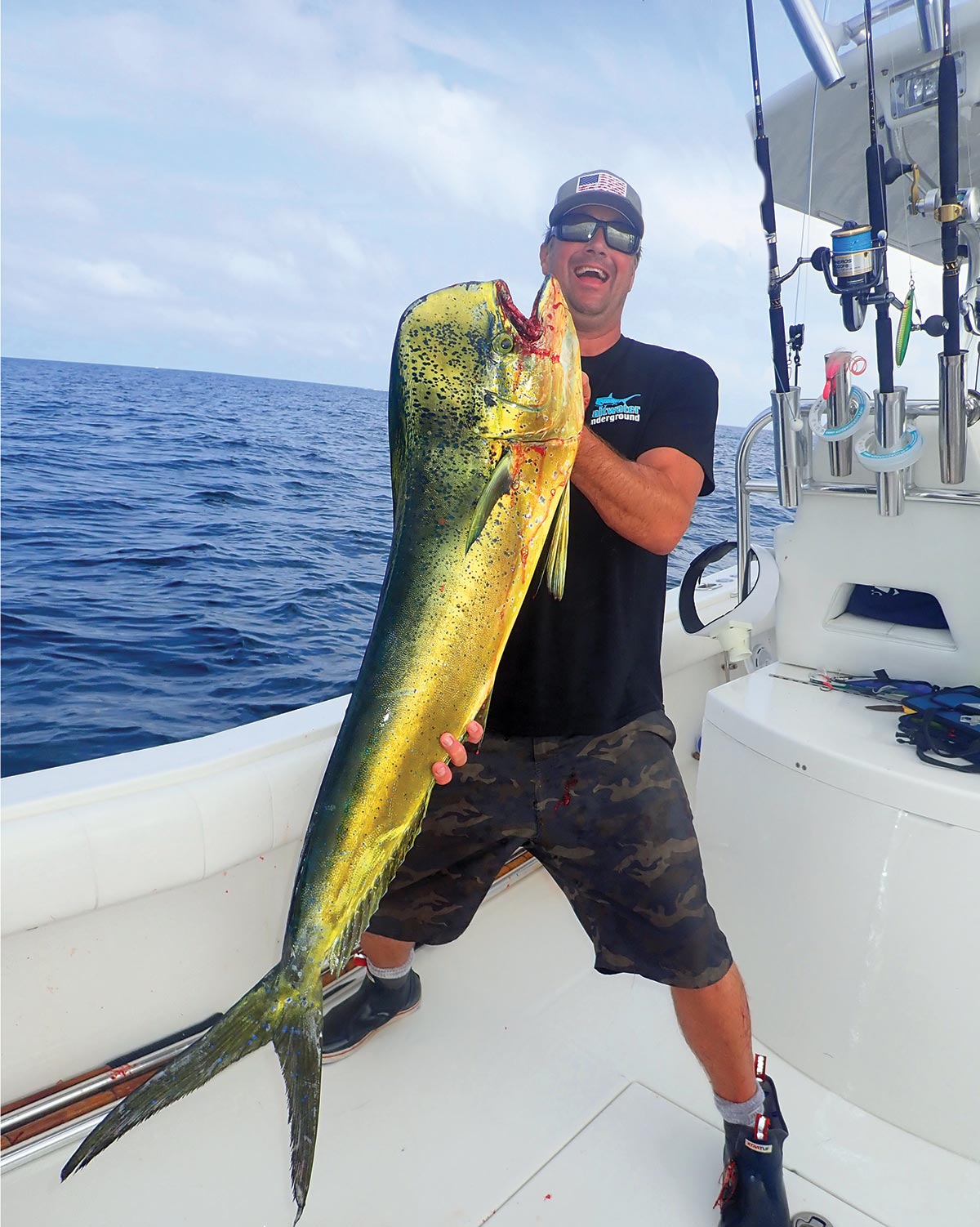
The Live Bait Pitch
“It’s all about live bait for pot mahi,” says mahi hound Capt. Kirk Fay out of Fire Island, NY. “Live bait really gets the fish to come alive. Mainly I like to use live snapper blues (remember only three per man) or live mullet. They are hardy baits though I do sometimes try peanut bunker but they always seem to die before you get out to the grounds.”
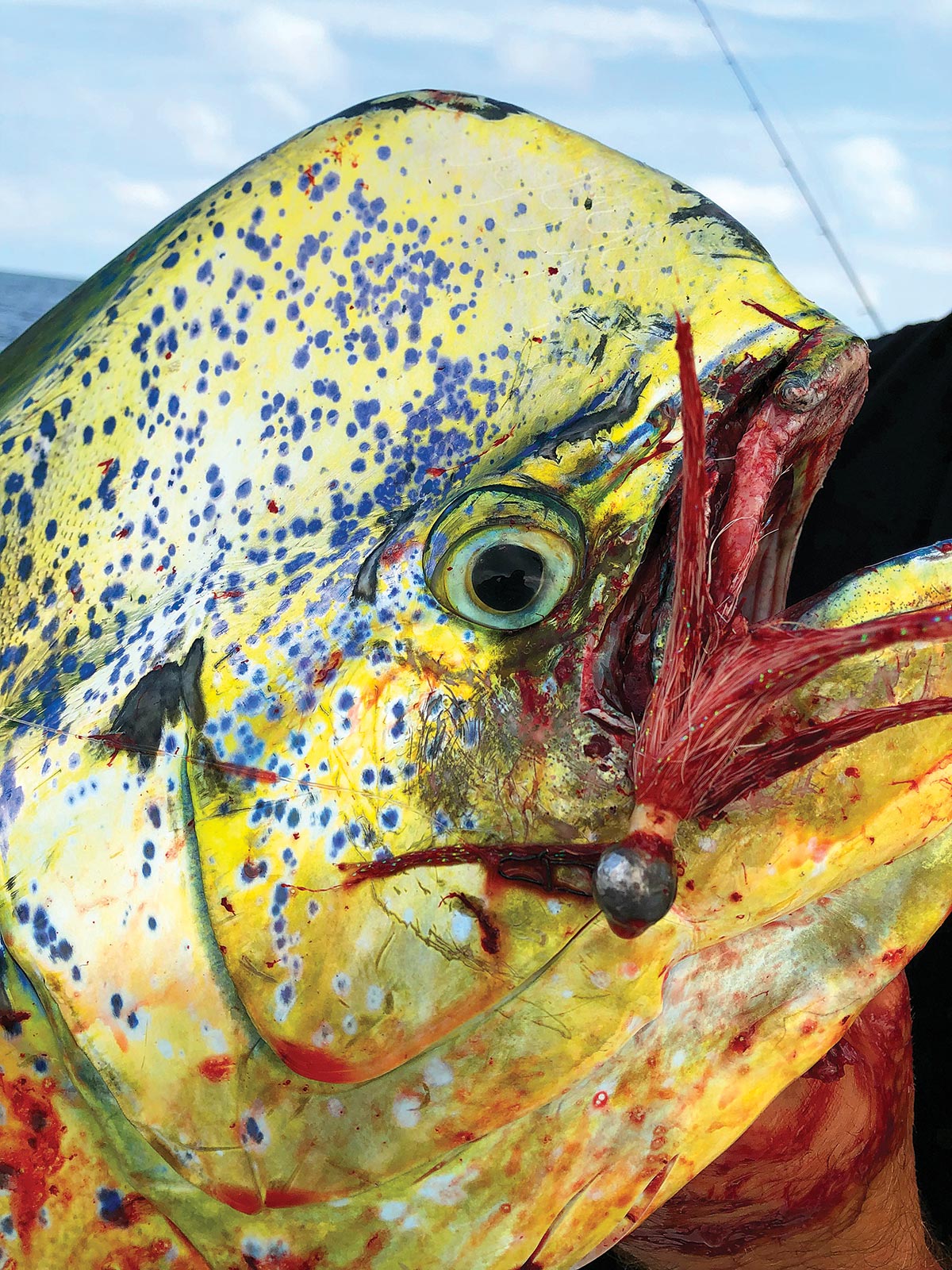
Once the area is picked out, Fay starts implementing his plan. “I begin by pulling up to a pot, tossing a handful of baits to see if any mahi are around and then to gauge if they are feeding,” states Fay. “If they are there but aren’t feeding, I’ll toss a topwater popper out and crash it violently on the surface to try and get them excited.”
A telltale sign when mahi are ready to feed is the firing of black vertical bars on their flanks. Fay will then send out the live bait rig, consisting of a 3-foot shot of 20- to 40-pound fluorocarbon leader snelled to a 2/0 Owner circle hook and the bait hooked underneath by the back of the tail.
Regarding the perfect time to target buoy dolphin Fay offers, “Many people think it’s all about sunup and sundown fishing but I like fishing during the middle of the afternoon when the sun is high, you can really see debris and identify the life hanging around it with the clarity of water.”
Fay also studies the life on the pot. “If you do see a bunch of grasshopper small dolphin around a pot, don’t just assume that’s the only size class there. Many times larger mahi will be hanging 40 feet or more below the surface on the line. I then pull off 40 feet of the running line and pinch a loop together, slide the loop through a small egg sinker, then loop on a rubber band and send the bait down where it will reach that proper depth.”
Fay’s live bait set up includes a 6-1/2-foot Ugly Stik spinning rod matched with a Shimano Baitunner 6000 spooled with 40-pound braided line.
Roll With The Troll
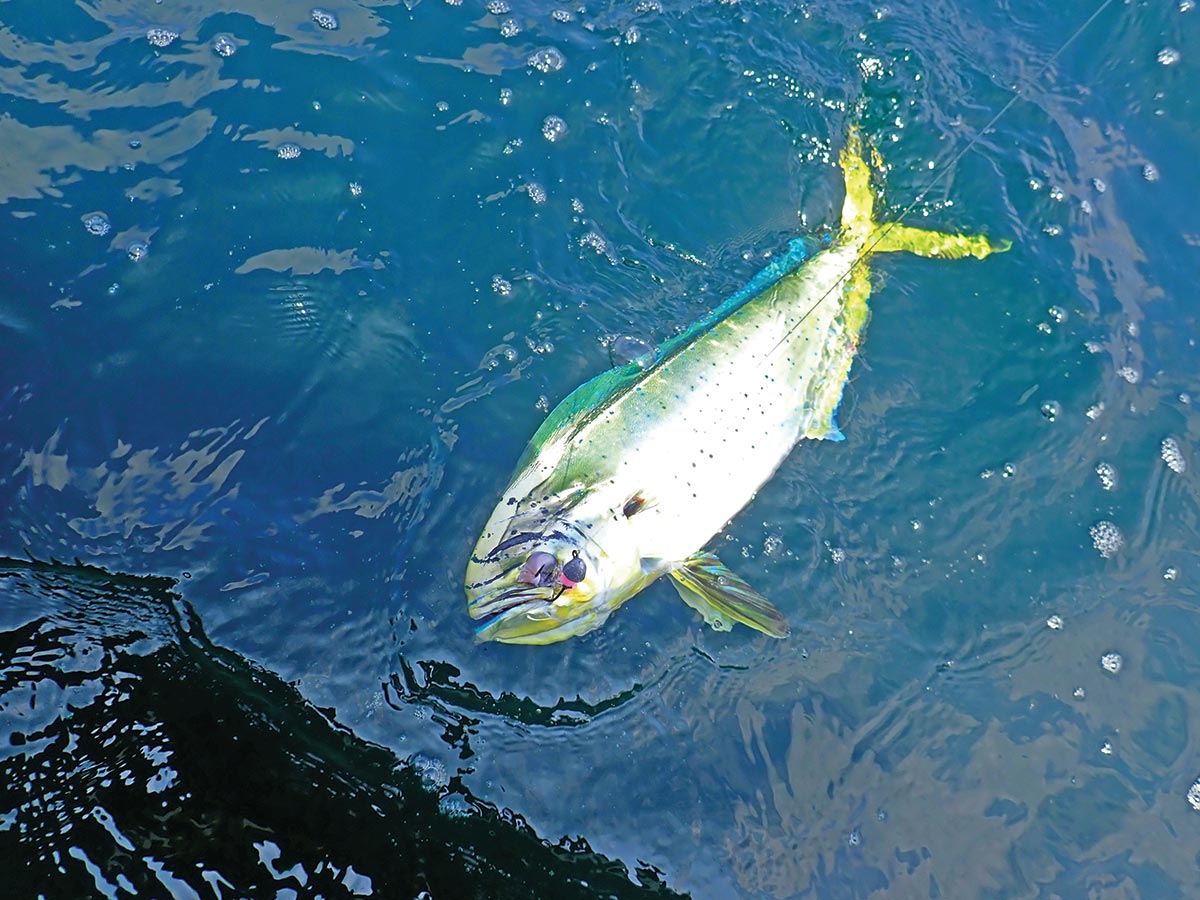
Kyle Douton of J&B Tackle and JB Sportfishing in Niantic, Connecticut prefers to get his customers on fish via trolling around the minefield of pots. “I look for ‘dirty gear’ that has been set in the water for a while, collecting marine growth and the chain of life around it,” stated Doughton. “Time of day can vary but I like sunny days as the ball buoy casts a shadow which attract mahi to come bask in the cool, dark shadow lines.”
In regard to finding the right buoy to troll by, Doughton offers, “You can troll by a pot in the morning with no fish on it and come evening its loaded and vice versa so the schools can move from one pot to the next. Keep moving around and stick to one if its producing, but don’t be afraid to leave it for a few hours and come back to try again.”
In his spread, Doughton will drag rigged Hexhead jets and 7Strand Tuna Clones in bright colors such as rainbow and zucchini patterns. “While trolling by buoys, I’ll also have two guys cast bucktails from the bow uptide of the ball and have them jig them as they sink and flow back into the trolling spread where we’ll just troll the bucktails behind.” Doughton states he will also have his charters jigging the flatlines in hand as they pass by a buoy so as to give added surge and attraction to the lures.
Buck Up The Buoys
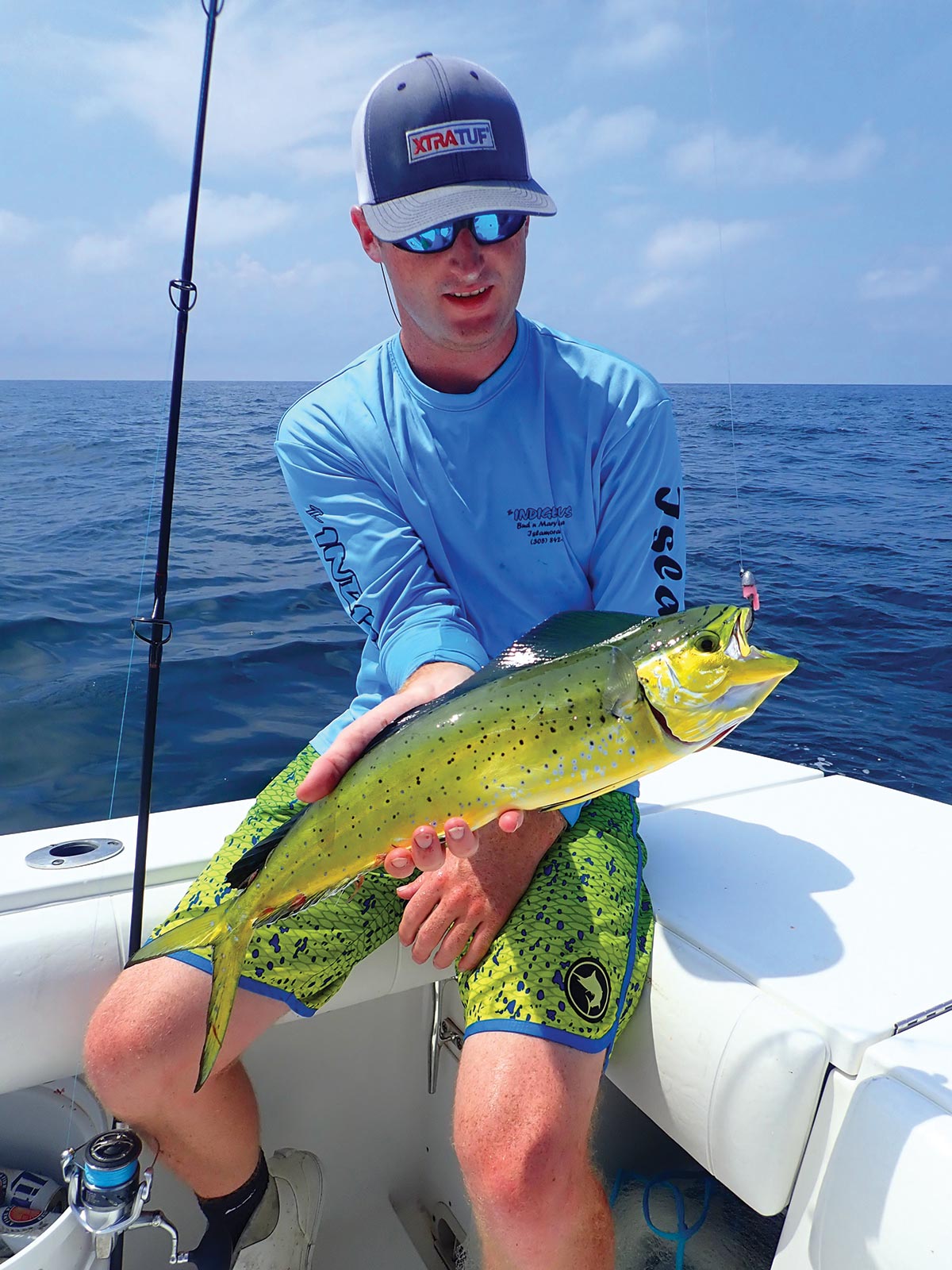
In the New Jersey area, I absolutely go bananas targeting mahi on pots during the late summer months. Along pot lines, dolphin are usually congregating due to the food chain that comes with the marine growth on the buoys and pot line. Small baitfish gather around in attempt to find shelter, but the mahi are wise to their plan.
Relatively small, light Magictail, S&S, Andrus or Spro bucktails of 3/8- to 1-ounce will work best to pull mahi off the pots as they can be jigged with maximum life-like effectiveness. White, white/chartreuse, and white/pink color patterns always seem to attract mahi. Without a doubt, tipping the bucktail hook with some flavor intensifies the attraction. Many offerings can be lanced on the hook, including fluke bellies, live killies, squid tentacles or strips, and any kind of strip bait like false albacore, bonito, bluefish or mackerel, or you can opt for artificials such as a Gulp! 5-inch jerk shad or 4-inch Swimming Mullet, or 5-3/4-inch Fin-S Fish in Albino Shad or Rainbow Trout. Try dipping the soft baits into FinEssence oil beforehand so the scent soaks into the bait.
When working a pot line or marker buoy, take the boat out of gear upcurrent of the target about a hundred yards, staying a good 40 feet or so away so as not to spook any fish. Make your casts past the target, allowing the bucktail to sink for a good three count. Proceed to jig the bucktail or soft bait in short, jerky strokes back to the boat.
According to NOAA Fisheries, Atlantic mahimahi, also known as dolphinfish, dolphin, dorado or simply mahi, are not subject to overfishing. Scientists assume populations are abundant because they are highly productive and widely distributed throughout tropical/subtropical oceans.
Capable of reproducing at 4 to 5 months old, Atlantic mahi is one of the fastest growing fish in the sea and can grow up to almost 7 feet and 88 pounds, living up to 5 years. It is believed that they’ll spawn every 2 to 3 days during the spawning season, releasing between 33,000 and 66,000 eggs each time. In the Atlantic, they spawn under patches of Sargassum.
Mahi are top predators that feed in surface water during the day, and eat a wide variety of species, including small pelagic fish, juvenile tuna, invertebrates, billfish, jacks, pompano, and pelagic larvae of nearshore, bottom-living species. In turn, natural predators include large tuna, marine mammals, marlin, sailfish, and swordfish.
NOAA Fisheries and the South Atlantic Fishery Management Council (in cooperation with the Mid-Atlantic and New England Fishery Management Councils) manage the Atlantic stock of mahimahi.
Present the bait naturally in the current. If you have drift, pass by the structure and are simply pulling the lure through the water, engage the engines and redo the drift again. If you aren’t getting any hits near the surface, allow the bucktail to sink a good 30 feet or so, then work it back up the water column, drawing up deep rooted dolphin.
My personal light tackle bucktailing outfit includes a 7-foot St. Croix TSMH70 rod rated for 15- to 30-pound, Shimano Stradic 5000 reel spooled with 30-pound Power Pro braid, then a 5-foot section of 25-pound Seaguar Fluorocarbon leader.
Minefield mahi can be an explosive endeavor. If you hit the right pots we’re talking hundreds of mahi can be caught in a day’s affair. If you get tired of bailing grasshopper fish on one pot buoy and work the lower water column yet still have no big gaffers come up, make the move to another pot to prospect where larger mahi may be hanging.
Of course, MOB any productive pot on your electronics that you left to come back to if you get blanked looking around. And don’t forget to bring plenty of ice for the cooler – you’re going to need it!

